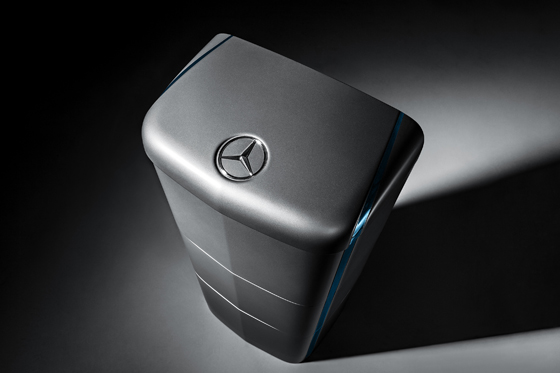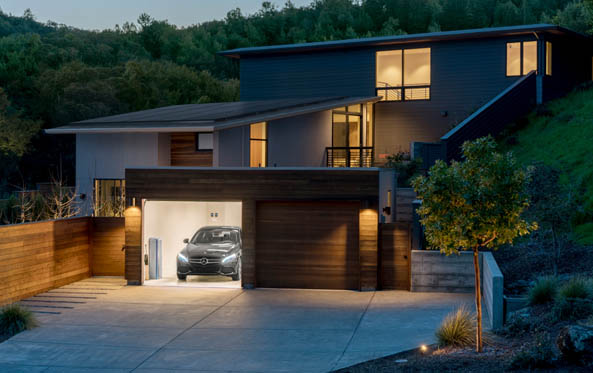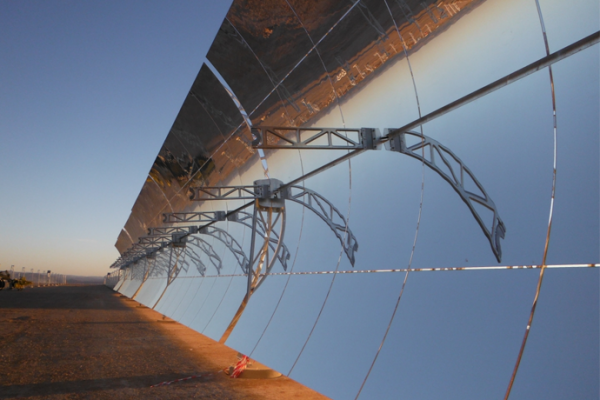One day we’ll have panels on the roof, a battery pack in the basement, and another in the carport. Boris von Bormann, CEO of Mercedes-Benz Energy Americas, connects the dots between electric vehicles, energy storage, and an exciting future.
Energy storage has long been considered key to ensuring the proliferation of renewable energy, and the long process of grid decarbonization. Where do vehicles plug in?
I have worked extensively in Germany, and elsewhere in the renewable energy sector, and we have always seen electric vehicles as a key element in the energy transition. Vehicles are both a load—they consume electricity while charging—and a mobile storage source. Instead of thinking about storage as a large battery in your home that will serve as an extension of your rooftop solar array, you can have another large battery in your life and you can be driving it around. So the renewables story is also a story of storage, and that will merge into a larger energy ecosystem that includes charging and all the other aspects around the electrification of transportation.

In recent months we’ve seen serious electrification commitments from a variety of internal-combustion-engine vehicle manufacturers, such as Volvo and GM. What does the timeline look like for Mercedes-Benz?
By 2022, Mercedes-Benz will have at least 10 fully electric cars, including at least one electrified alternative in every Mercedes-model series. We already have several plug-in hybrids on the market, such as the C-Class, S-Class, and the GLE, which we believe will play an important role in this transition. But for us, it’s about more than just cars. We are looking at storage and the full electric vehicle ecosystem, and what those elements might look like. We have our own battery manufacturing plant in Kamenz, Germany, and are investing a billion euros in the expansion of our global battery production, with plans to produce EVs and batteries in the US and China as well. We really think there will be more to electric vehicles than just the cars.
What do you mean?
The customer will expect more. We know that many of our customers will want to generate their own electricity through rooftop solar panels and store that for the home, or use it to charge the vehicle, or sell it back to the grid from the battery in either the vehicle or the home. We want to develop all of these elements.
Germany and other European nations have strong policies and incentives in place to encourage distributed rooftop solar generation. But you’re based in the United States, where the traditional centralized utility plant models still have a stronghold in many states, and policy is uneven. Why have a headquarters there?
On the vehicle side, North America is one of the key markets for Mercedes-Benz. The electric vehicle market in the United States is certainly growing, especially in California and the nine other states with zero-emissions vehicle mandates: Connecticut, Maine, Maryland, Massachusetts, New Jersey, New York, Oregon, Rhode Island, and Vermont. So with a home energy ecosystem where storage is complementary to electric vehicles, the US market is very important for us.
And these lead electric vehicle markets are also your target markets for energy storage?
Sure. There are a few states that are really focused on storage, such as Hawaii and California. We see quite a few large markets in North America that have significant growth potential—both from the perspective of a home battery as a complement to the EV in the garage, but also just as a pure play of solar panels with home storage.
We’re very much in the early adopter stage when it comes to this home-energy ecosystem. What are the biggest barriers to mass adoption?
The big one is still the cost of batteries. But as the electric vehicles are coming to scale, we’re seeing a rapid drop in battery prices, which is one of the hurdles to drive overall system costs down for batteries and storage systems. That’s going to lead to large adoption of systems that are affordable for most people and have an economic benefit to customers.
We expect there will be a lot of capacity available through “second use” of batteries. By that I mean that a battery that’s been used in a vehicle could be refurbished and repurposed for home use. That is going to drive the cost down even further. So, prices of new batteries are dropping, and as second-life batteries start to come on the market, I expect we’ll see a large distribution of energy storage systems, because they are going to become economically feasible.
Price is a biggie, obviously. But what other, non-economic factors will come into play?
On one side, people are interested in becoming more independent from a third-party energy supplier. There’s something exciting about that idea that really registers with people, whether it’s for environmental or other reasons. We also have a growing number of people having contact with electric vehicles. The act of moving from a pump to plug shifts perceptions about where energy “comes from.” We have found that the people who own rooftop solar are much more likely to own an EV than people who do not have solar. So, really, when it comes to energy usage, people are looking to become more transparent.
What are the benefits for utilities?
We really see that storage is going to be a huge asset for utilities, and for the grid as a whole, because it strengthens the network. However, it needs to be done intelligently. I don’t personally think that every home should have solar storage; at some point it needs to become more of a shared asset, a community asset. We’ll have people that won’t have the ability to have solar on their roof because it’s not a good site, and others will be renting, or living in an apartment. So, how we make that whole community aspect happen, that’s really one of the key challenges.
Do you anticipate any issues when the adoption curve takes off, and hundreds, and eventually thousands, of people start installing micro-generation plants on their homes—and batteries in their utility room and carport—and then they wire all that into the grid?
As technologies mature, it’s going to become a non-issue. With the huge adoption of solar in Germany, for example, it’s already, more or less, a non-issue. Grid operators will use predictive software, computer learning, machine learning, and artificial intelligence to anticipate customer behavior and demand, and match it up with capacity. That’s going to take away the unpredictability and make that energy source quite certain and reliable.
You paint a compelling future of a completely reinvented energy system, but what will the even longer-term innovations look like?
To get into the double-digit percentages of renewable energy, you need some form of storing the energy for when you really need it. You have solar generation all day while people are at work, and then they come back in the evening when solar drops off, and you need this sudden ramp up of load. If you can store the energy, hold it on a more even level, and therefore manage these large ramp-ups on the grid, that’s really what’s going to help us drive us towards the clean energy economy.
Then there are seasonal variations. It’s hard for Germany, for example, with its longer winter, to reach a true 100% clean-energy footprint in the home. Maybe you can reach 80-82%, with storage. However, if your cost of energy storage is low, then you can create some off-season storage space. We can have large battery banks that store energy during summer and make it available during the winter. If you can achieve that kind of scale, that’s going to drive the global clean energy economy to a point where it’s affordable, and largely available in all areas of the world.
So, in the future we won’t just be storing off-season clothes or gear, we’ll be parking electrons! In closing, what do you hope to get out of GLOBE Forum?
We really need to take a holistic approach to energy and mobility, and convey how the electric vehicle and transportation and mobility sectors are starting to intertwine with the energy sectors. How do we drive towards solutions without blinders on? When we have all the experts of these industries working together, we come up with efficient solutions and real solutions that work for a long time and make economic sense. I want to forge connections between the electric transportation, clean energy storage, and renewable energy players—and that’s where GLOBE Forum excels because it brings all those together in one place.
At GLOBE Forum 2018, Boris will speak on the Energy and Technology conference track, examining the barriers and opportunities of ramping up the energy storage solution.




